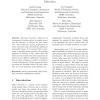Free Online Productivity Tools
i2Speak
i2Symbol
i2OCR
iTex2Img
iWeb2Print
iWeb2Shot
i2Type
iPdf2Split
iPdf2Merge
i2Bopomofo
i2Arabic
i2Style
i2Image
i2PDF
iLatex2Rtf
Sci2ools
ICAI
2004
2004
Reducing False Alarms Using Genetic Programming in Object Detection
: This paper describes a refinement of an approach to locating objects in complex images with the objective of reducing the false alarm rate. The method uses genetic programming to evolve a detector using a threshold for defining an unclassified region. It is envisaged that incorporating a threshold during training will encourage programs to produce a high output when the object has been located. The objects required to be located are two difficult cephalometric landmarks that are either ambiguous in nature or located in a cluttered background. Results suggest that while increasing the threshold reduces the false alarm rate, it is to the detriment of the detection rate.
Difficult Cephalometric Landmarks | False Alarm Rate | ICAI 2004 | ICAI 2007 | Unclassified Region |
| Added | 31 Oct 2010 |
| Updated | 31 Oct 2010 |
| Type | Conference |
| Year | 2004 |
| Where | ICAI |
| Authors | Andrew Innes, Victor Ciesielski, John Mamutil, Sabu John |
Comments (0)

